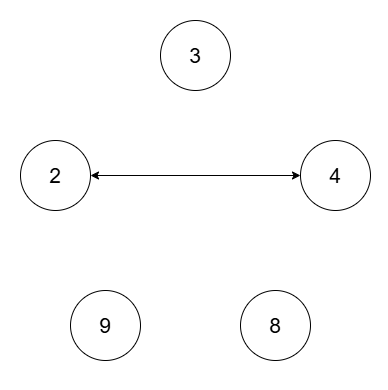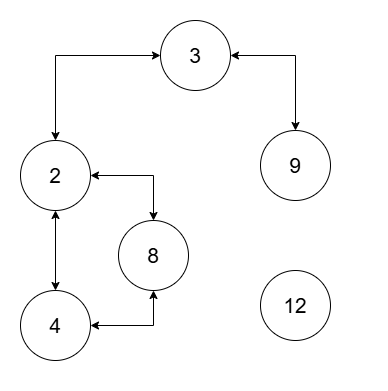题目描述
给你一个长度为 n 的整数数组 nums 和一个 正 整数 threshold。
有一张 n 个节点的图,其中第 i 个节点的值为 nums[i]。如果两个节点对应的值满足 lcm(nums[i], nums[j]) <= threshold,那么这两个节点在图中有一条 无向 边连接。
请你返回这张图中 连通块 的数目。
一个 连通块 指的是一张图中的一个子图,子图中任意两个节点都存在路径相连,且子图中没有任何一个节点与子图以外的任何节点有边相连。
lcm(a, b) 的意思是 a 和 b 的 最小公倍数。
样例
输入:nums = [2,4,8,3,9], threshold = 5
输出:4
解释:
四个连通块分别为 (2, 4),(3),(8),(9)。

输入:nums = [2,4,8,3,9,12], threshold = 10
输出:2
解释:
两个连通块分别为 (2, 3, 4, 8, 9) 和 (12)。

限制
1 <= nums.length <= 10^51 <= nums[i] <= 10^9nums中所有元素互不相同。1 <= threshold <= 2 * 10^5
算法
(并查集) $O(n + threshold \log threshold)$
- 遍历所有的数字,并把每个数字和它的倍数通过并查集连接,直到倍数达到 $threshold$。
- 如果某个数字超过了 $threshold$,则不操作并查集,答案直接累加 $1$。
- 遍历每个小于 $threshold$ 的数字,统计这些数字所占的连通块的个数,累加到答案中。
时间复杂度
- 并查集单次操作的时间复杂度近似为常数。
- 遍历所有数字和它的倍数,由于所有数字互不相同,则总的时间复杂度不超过 $O(n + threshold \log threshold)$。
- 累加答案的时间复杂度为 $O(n)$。
- 故总时间复杂度为 $O(n + threshold \log threshold)$。
空间复杂度
- 需要 $O(threshold)$ 的额外空间存储并查集。
C++ 代码
class Solution {
private:
vector<int> f, sz;
int find(int x) {
return x == f[x] ? x : f[x] = find(f[x]);
}
void add(int x, int y) {
int fx = find(x), fy = find(y);
if (fx == fy)
return;
if (sz[fx] < sz[fy]) {
f[fx] = fy;
sz[fy] += sz[fx];
} else {
f[fy] = fx;
sz[fx] += sz[fy];
}
}
public:
int countComponents(vector<int>& nums, int threshold) {
f.resize(threshold + 1);
sz.resize(threshold + 1, 1);
for (int i = 1; i <= threshold; i++)
f[i] = i;
int ans = 0;
for (int x : nums) {
if (x > threshold) ++ans;
else {
for (int i = x + x; i <= threshold; i += x)
add(i, x);
}
}
unordered_set<int> h;
for (int x : nums)
if (x <= threshold && h.find(find(x)) == h.end()) {
++ans;
h.insert(find(x));
}
return ans;
}
};

